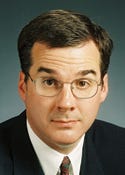Originally Published MDDI February 2006
February 1, 2006
Criticism, Reform on FDA Agenda
|
This past year was one of upheaval for FDA. Former commissioner Lester Crawford resigned under pressure just two months after his confirmation. The agency came under fire from Congress for a number of reasons, including concern over postmarket issues. And CDRH's funding scheme underwent significant changes. It will be up to acting commissioner Andrew C. von Eschenbach and CDRH director Daniel Schultz to ensure FDA's ship is righted and CDRH meets its objectives for the near future.
Crawford resigned in September and now HHS's Office of Inspector General is investigating the reasons for his departure. The probe so far is focusing on Crawford's finances. As late as 2004, he or his wife owned stock in companies with products regulated by FDA, raising conflict-of-interest issues.
This is one of several ways in which FDA came under fire for being too cozy with industry. It was especially chastised for being lax in ensuring postmarket safety of products it approved. At first, the debate was mostly confined to drugs, thanks to the Vioxx scandal. But by May 2005, it spilled over into devices, when a handful of implantable cardioverter-defibrillators, made by Guidant Corp. (Indianapolis), were revealed to have short-circuited and CDRH had not acted despite being made aware of the problem.
One of FDA's most vocal critics has been Senator Charles Grassley (R–IA), chairman of the Senate Finance Committee. Grassley has been trying to assert jurisdiction over FDA reform because FDA's processes affect commerce, Paul Kim, an attorney with Washington, DC, law firm Foley Hoag LLP, told those at MassMEDIC's FDA Update in December.
|
Bradley Thompson thinks a lack of FDA leadership could hurt MDUFMA reauthorization. |
“He believes FDA is not carrying out its statutory responsibilities,” Kim said. “I expect his criticisms to continue unabated. If he wants to make legislation, he will have to go through the Health Committee, but that won't stop him from continuing his scrutiny. However, he does have jurisdiction over Medicare and Medicaid.”
Partially as a result of such criticism, CDRH made sweeping changes to postmarket surveillance. It shifted responsibility for monitoring postmarket condition-of-approval clinical studies to the Office of Surveillance and Biometrics and is overhauling its adverse-event reporting programs, such as medical device reporting (MDR).
“Personally, I think the MDR process is totally mismanaged,” says Larry Pilot, a partner at Washington, DC, law firm McKenna, Long & Aldridge LLP. “There has been very little done as far as analysis of the numbers the agency receives. What is the output? Can a benefit of this collection be demonstrated? [FDA is] not using the reports wisely. They are just numbers coming in. My thought is that the agency just doesn't get it.”
Many industry insiders have faith in Schultz and his team to work out the kinks, even if there is no permanent commissioner forthcoming. “Over a short period of time, the agency can function on autopilot” without a permanent leader, says Bradley Thompson, a partner at Baker & Daniels (Indianapolis). “But the MDUFMA [Medical Device User Fee and Modernization Act of 2002] reauthorization is coming up, and that's where a lack of leadership could serve to impede the agency. The agenda has got to be set for the long term, and if there is no leader for the long term, there becomes a question of how well the agency can follow through.”
The first step in that overhaul occurred in 2005 with the passage of the Medical Device User Fee Stabilization Act. As a result of industry concerns about escalating user fees, the law caps fee increases at less than 9% per year. That may not affect CDRH's ability to do its job if Congress comes through with funding it promised. But with FDA out of the good graces of many members of Congress, can the agency get what it needs to accomplish its mission? This will be one of the most pertinent questions of 2006. —ES
Copyright ©2006 Medical Device & Diagnostic Industry
You May Also Like




